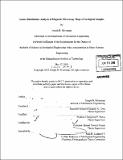| dc.contributor.advisor | Eduardo A. Lima, Benjamin P. Weiss and Kamal Youcef-Toumi. | en_US |
| dc.contributor.author | Silverman, Joseph B | en_US |
| dc.contributor.other | Massachusetts Institute of Technology. Dept. of Mechanical Engineering. | en_US |
| dc.date.accessioned | 2010-11-08T17:45:08Z | |
| dc.date.available | 2010-11-08T17:45:08Z | |
| dc.date.copyright | 2010 | en_US |
| dc.date.issued | 2010 | en_US |
| dc.identifier.uri | http://hdl.handle.net/1721.1/59915 | |
| dc.description | Thesis (S.B.)--Massachusetts Institute of Technology, Dept. of Mechanical Engineering, 2010. | en_US |
| dc.description | Cataloged from PDF version of thesis. | en_US |
| dc.description | Includes bibliographical references (p. 52-53). | en_US |
| dc.description.abstract | Superconducting quantum interference devices (SQUID) are currently the most sensitive magnetometers for geological samples. Standard SQUID magnetometers are able to directly estimate the net moment of a sample, while SQUID microscopes require complex inversion of maps of the magnetic field above the sample. In order to extract magnetization information from SQUID microscope measurements, it is customary to model the sample as a distribution of magnetic dipoles. The calculations required for this operation in the space domain typically involve a pseudo inversion which becomes problematic due to the large amount of data, measurement noise, inherent loss of information in computational discretization, and ambiguity in determining an optimized "best" solution. To ameliorate these problems, we have implemented several regularization techniques and constraints. Using synthetic, computationally generated measurements, our investigation demonstrates that Tikhonov regularization with a high pass filter matrix performs better than unregularized least square methods, truncated singular value decomposition, and Tikhonov regularization using an identity matrix (minimum norm). Our study also gives insight regarding the benefit and cost of setting various constraints. Our findings are then tested on real measurements of a sample of shocked basalt and a test sample comprised of a section of a refrigerator magnet. | en_US |
| dc.description.statementofresponsibility | by Joseph B. Silverman. | en_US |
| dc.format.extent | 53 p. | en_US |
| dc.language.iso | eng | en_US |
| dc.publisher | Massachusetts Institute of Technology | en_US |
| dc.rights | M.I.T. theses are protected by
copyright. They may be viewed from this source for any purpose, but
reproduction or distribution in any format is prohibited without written
permission. See provided URL for inquiries about permission. | en_US |
| dc.rights.uri | http://dspace.mit.edu/handle/1721.1/7582 | en_US |
| dc.subject | Mechanical Engineering. | en_US |
| dc.title | Source distribution analysis of magnetic microscopy maps of geological samples | en_US |
| dc.type | Thesis | en_US |
| dc.description.degree | S.B. | en_US |
| dc.contributor.department | Massachusetts Institute of Technology. Department of Mechanical Engineering | |
| dc.identifier.oclc | 676696350 | en_US |
